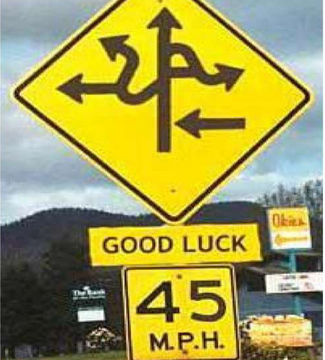Navigating Leadership Transitions, a compilation of guidelines from LWS
Leading with Spirit
How to Navigate and Manage Successful Transitions
Life is constantly in transition and organizations reflect this. The dynamics of transitions, especially abrupt or unforeseen/unplanned changes in leadership positions, require conscious attention to an array of factors. The following article outlines some key areas that are helpful to consider in moving through and managing a successful transition. It borrows from important work from a variety of sources.
Understanding Transitions (William Bridges)
The Bridges Transition Model helps organizations and individuals understand and more effectively manage and work through the personal and human side of change. The model identifies the three stages an individual experiences during change: Ending What Currently Is, The Neutral Zone and The New Beginning. Developed by William Bridges, the Bridges Transition Model has been used by leaders and management consultants for more than thirty years.
What is the difference between change and transition?
Change is the external event or situation that takes place: a new business strategy, a turn of leadership, a merger or a new product. The organization focuses on the desired outcome that the change will produce, which is generally in response to external events. Change can happen very quickly.
Transition is the inner psychological process that people go through as they internalize and come to terms with the new situation that the change brings about. Empathetic leaders recognize that change can put people in crisis. The starting point for dealing with transition is not the outcome but the endings that people have in leaving the old situation behind.
Change will only be successful if leaders and organizations address the transition that people experience during change. Supporting people through transition, rather than pushing forward is essential if the change is to work as planned. This is key to capitalizing on opportunities for innovation and creating organizational resilience.
What are the stages of transition?
Endings
Transition starts with an ending. This is paradoxical but true. This first phase of transition begins when people identify what they are losing and learn how to manage these losses. They determine what is over and being left behind, and what they will keep. These may include relationships, processes, team members or locations.
Neutral Zone
The second step of transition comes after letting go: the neutral zone. People go through an in-between time when the old is gone but the new isn’t fully operational. It is when the critical psychological realignments and repatternings take place. It is the very core of the transition process. This is the time between the old reality and sense of identity and the new one. People are creating new processes and learning what their new roles will be. They are in flux and may feel confusion and distress. The neutral zone is the seedbed for new beginnings.
New Beginnings
Beginnings involve new understandings, values and attitudes. Beginnings are marked by a release of energy in a new direction – they are an expression of a fresh identity. Well-managed transitions allow people to establish new roles with an understanding of their purpose, the part they play, and how to contribute and participate most effectively. As a result, they feel reoriented and renewed.
What is the transition management process?
Transition management in organizations addresses the inner psychological process that people experience during change. Successful transition management involves these steps:
- Communicating with the organization about why the change is needed.
- Collecting information from those affected by the change to understand its impact on them. Gaining their investment in the outcome.
- Doing an audit of the organizations’ transition readiness.
- Educating leaders about how the change will affect individuals in the organization to manage the transition effectively.
- Monitoring the progress of individuals as they go through the three stages of transition.
- Helping individuals understand how they can positively contribute to the change and the importance of their role in the organization.
For more information, visit https://wmbridges.com/
A Checklist of HR Tips for Sudden Leadership Transitions
When an important leader makes an abrupt exit from your company, the departure can leave your employees, customers and even the remaining leaders feeling uncertain.
Unanswered questions can inspire rumors about the past and cast doubts over your company’s future. That’s why it’s imperative to communicate well when there’s a sudden change in leadership.
Whether you’re dealing with this situation now or want to be prepared in the future, let’s talk through:
- What can you say to employees?
- What can you tell your customers?
- How much detail should you give about the person’s departure?
- What should be done if they don’t take the news well?
- How can a leader reassure everyone that things will be fine?
When you’re speaking with employees and customers, these communication guidelines will give you a solid strategy for getting everyone moving forward together.
- Assign communication responsibilities.
- Acknowledge the change quickly.
- Stick to the facts and future.
- Confirm what won’t change.
- Give details relative to level of involvement.
- Be mindful of compliance.
- Acknowledge conflicting values when needed.
- Let employees move through the change cycle.
- Remember these notes to self.
As part of the interim or replacement leadership team, you’ll likely be going through your own change cycle in the wake of a colleague’s sudden departure.
To stay positive and productive yourself, don’t forget to:
- Avoid criticizing the outgoing leader.
- Value the work that’s been done.
- Ask employees what the former leader did well.
- Ask what the former leader could have done better.
- Keep an eye out for new leaders who step up.
by Insperity Staff | Human Resource Advisor | Houston, Texas
Factors Contributing to Successful Transitions (a compilation by Leading with Spirit)
- There is an agreement that you are facing a transition and that it needs attention to assure that the community and individuals are supported through the change in a good way.
- There is an agreement that management of the transition process will require additional time, energy and resources and a group of trusted people are empowered to provide leadership on behalf of the whole and are supported by existing groups and individuals.
- The value of outside advice, support, coaching or facilitation (consultant) is recognized. If a consultant/facilitator is hired, a plan for supporting and managing the consultant is created.
- Clearly articulated Goals, for example:
- Increased parent confidence
- Improved management
- Clarity regarding roles and responsibilities
- Improved balance in work/life
- It is acknowledged that there is instability and some chaos inherent in transitions and there is a thorough assessment of the nature of the transition/change and the potential effect it may have on individuals, groups and processes. There are plans put in place to manage any processes/tasks that need immediate attention and there are plans to deal appropriately with guilt, resentment, or anxiety that may emerge in people as a result.
- It is recognized that with every transition, there is the need to review (identify and consider) assumptions, risks, dependencies, costs, and cultural issues. Transitions, once the basics are attended to, can be a good time to consider doing an audit of processes, systems, or governance.
- It is recognized that every transition affects people in different ways. For the staff, there is a conscious identification of the interim procedures and agreements regarding managing everyday processes and making decisions.
- It is recognized that transitions effect everyone in the organization and community (stakeholders) to some degree and that each group’s (and every individual’s) input, perspective and insights are valued and considered.
- It is recognized that clear and regular communication is essential to a successful transition including communication that informs various stakeholders of:
- the realities of the situation, details (why and what)
- goals, process and leadership for the transition
- benefits of successful implementation (what is in it for us, and you)
- timeline, costs and expected outcomes
- ways in which stakeholders will be involved, engaged
- avenues for listening to and responding to concerns and/or resistance
- modes of support being offered to alleviate any change-related fears
- ways in which the process will be monitored, reviewed, evaluated, and fine-tuned.
- the celebration and orientation to new people, structures, and agreements (roles, responsibilities and processes)
- A communication plan is put into place that addresses the above
- In personnel transitions, there is a plan to facilitate the best possible departure for the person(s) leaving, including appropriate rituals for the organization and community culture.
- A plan is in place for recognizing and celebrating what is new when the transition is over, including:
- What people have taken on
- What new practices and procedures have
- been developed
- What new agreements have been made
- A plan is created for ongoing review and evaluation moving into the future.
- Individuals are encouraged and supported to take care of the effects the transition has on their soul and time is allotted for talking through feelings connected to the transition.
- Successful transition/change is reviewed and celebrated.
Change and the Threefold Organization
School Transitions in light of the threefold aspect of the school
All transitions have effects in each of the three realms of the school (individual, social and organizational). Because each realm has a particular qualitative character and expresses different aspects of the school life and wholeness, it can be helpful to look at any transition from three vantage points
Cultural Realm (social realm)
The cultural realm is the realm of agreements, and is most connected to the understanding of each person as a equal part of the community who participates in the life of the school as an equal, committed to the mission, the goals, the values, the rules, the procedures and the policies – all the agreements that together express the culture and spirit of the school. In this area, people want to know that they are protected, valued and seen as part of the process and that negative effects of the change are being dealt with. Focus: Confidence
Acknowledge (and if appropriate, celebrate) the change
Be open and consistent with handling the change
Strive to rely on values and agreements that are in place and allow each situation to inform the growing evolving body of agreements.
Make every effort to keep everyone appropriately informed. As a community, everyone has the right ot know at an appropriate level.
Communicate timely, regularly, clearly, respectfully and appropriately to every group.
Assure people that leadership is aware of the transition, its effects and are addressing it in a timely and well thought out way (build confidence)
Personal and Inter-Personal realm (individual realm) The personal - interpersonal realm is the realm of creativity, encouragement, recognition of individual gifts and contributions, and commitment to growing and developing through self development and through the shared development of relationships. In this area, people want to know that they are unique and individual, that they are allowed to learn and grow in their own particular way and that others are also committed to self development. Focus: Dealing with individual feelings and relationships
Consider and recognize the effect the change might have on each person, and each group – it might be a personal relational change and it might be a change of process.
Allow individuals to help by sharing their experiences
Provide opportunities where people can be heard and conversed with
Attend to conflicts directly and in a timely way
Help by reminding people that they are valued, their experience and insight is valued.
Structural and Process realm (Earth/Organization realm)
The structural earlthy realm is the realm of structures and forms and resources where each person is seen as a part of a working whole and through the common good, indivudals are supported in their work and development. In this area, people want to know that there are structures and a kind of architecture that holds the organization in place at any given time – structures and forms that allow individuals and groups to relax knowing that the dynamics of everyday work are being help together by a conscious whole that is informed and formed out of the highest values and ideals of the organization.
Focus: Responsibility
Attention is given to the fact and details of the change and it is understood that the transition will require resources to manage.
The change is acknowledged by leadership at all levels of the school
Attention is given to any underlying factors influencing the change and an effort is made to assess how the change might lead to new possibilities in line with the school’s mission and values.
All the tasks related to the change are reviewed and plans are in place for taking care of the them in the interim.




